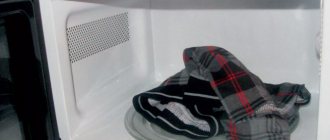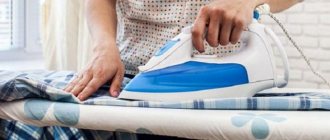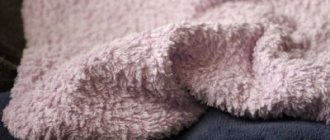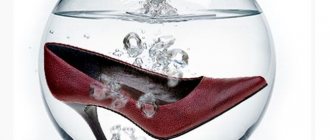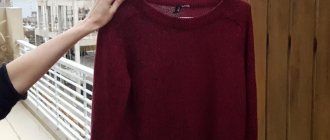The appearance, condition and service life of clothing depend not only on proper washing, but also on proper drying.
A frivolous approach leads to deformation of products - stretching in width or length, yellowing, wrinkles, thinning and fragility of the fabric.
When choosing a drying method, you need to take into account the type of product and the composition of the material. It is equally important to pay attention to the general rules and recommendations that will help dry clothes quickly and efficiently.
Let's take a closer look at how to quickly and properly dry clothes after washing at home.
In the washing machine
This option is perfect for situations when you need to urgently dry one or two items.
Having hung the rest of the laundry on the lines, the items to be dried must be returned to the drum - and the drying function must be turned on. The main thing is not to overdo it with the temperature. It is optimal to choose a front sight mode based on the characteristics of the fabric. If after this procedure things are slightly damp, you can always dry them with an iron. But what to do if the washing machine does not have a drying function? We'll fix everything! You can simply place a couple or three thick terry towels in the drum along with wet things and turn on the most intense spin.
The towels will absorb the water from the outfits - and it will just become a little damp. After “drying” the item can be ironed with a hot iron - this will evaporate the remaining moisture. Clothes will dry completely in about thirty minutes.
How to dry clothes quickly
There are ways to speed up the process of drying clothes several times.
The only thing is to pay attention to the material from which the product is made and not to overdo it with the heat source
Using the oven
It is necessary to turn on the oven, do not place a chair too close, on the back of which the laundry is hung. The oven door must be opened. It will take thirty minutes to an hour. During this time, you need to turn the product over several times to better evaporate moisture.
It needs to be heated to 200 °C and the door should be opened. Place a chair nearby and hang clothes.
This drying method is acceptable if the household appliance is clean, free of greasy stains and soot. Otherwise, the material will absorb the odors of meat or baked goods.
The oven must be cleaned, otherwise the clothes will smell of food.
Hairdryer
This method is suitable for items made of synthetics and wool. You can hang clothes on a chair, or use a hanger. The hair dryer should be directed at a distance of half a meter from the product. You need to blow a stream of hot air over the item from all sides for about half an hour. After completing manipulations with the hairdryer, let the product cool for five minutes, after which you can put it on.
To dry clothes at home without damaging the fiber structure, use hot air that comes from a hair dryer.
This useful household appliance is ideal for drying socks. To do this, just pull the socks and stockings onto the concentrator, then turn on the air supply. Seven minutes is enough to completely dry the product.
The procedure takes only a few minutes.
Terry towel
An excellent method for those who do not yet know how to quickly dry denim items. Suitable for sweaters and wardrobe items made of thick fabrics. It is necessary to wrap the wet item in a dry terry towel, lightly squeeze it or put it under a press. It is advisable to replace the towel with a dry version a couple of times, repeating the steps two or three times. If the material remains damp, dry it with a hairdryer.
Textiles dry well outside, in a loggia with an open window.
Battery
In the autumn-winter period, the battery saves. Everything is simple here:
- It is worth covering the surface of the battery with a clean piece of cloth or sheets. This will prevent the item from possible contamination;
- Lay wet clothes on top;
- Drying takes from 40 minutes to two hours.
Small wardrobe items are laid out on an electric radiator, shirts and jackets are placed next to it.
Socks, mittens, and hats dry especially well on the radiator. It is not advisable to dry a heavy knit pullover in this way; it will deform the shape from the sections. Also, the item will dry faster if you periodically turn it over and shake it.
The oil battery significantly accelerates the evaporation of moisture.
How to quickly dry a jacket and coat
It is better to dry outerwear, including jackets and coats, in natural conditions. After washing, a fabric coat should be combed with a special brush so that the fibers straighten. Then the product is hung on hangers and left at room temperature with good air circulation. To make it dry faster, use a fan heater or hair dryer with hot air.
You can also quickly dry a leather jacket using a fan heater. Do not hang wet or damp items in a closet, on the back of a chair, on a clothesline, or on a door. A leather jacket can only be hung on a hanger that is suitable in size.
This product is not recommended to be washed. The skin is cleaned using dry methods using a soap solution, ammonia, starch, vinegar or soda. Do not use gasoline or acetone for cleaning!
If your leather jacket is exposed to rain, remove items from the pockets, wipe the material with a dry, clean cloth, and hang it on a hanger with wide hangers. Leave the clothes to dry at room temperature. A leather jacket should not be dried on radiators or radiators, or near electrical appliances!
Failure to follow these rules will result in the delicate material becoming wrinkled and deformed. Creases and folds will appear on the leather, the product will fade and lose its original color.
Specialized sprays, onion, Vaseline, moisturizing hand cream and other available products will help restore the former shine to leather clothes. How to renew and restore leather items, get rid of bruises and creases, read the article “Caring for a leather jacket.”
Precautionary measures
You should not thoughtlessly dry the product using the first, seemingly reasonable method you come across. This can ruin an item or household appliance. Here are a few tips to consider before you start drying:
- Under no circumstances should you dry things over a stove or other open fire sources. Firstly, some products may shrink. Secondly, the fabric is flammable; a very small thread can lead to a fire. At best, the clothes will be damaged, at worst, a fire will start.
- Do not dry clothes on electrical heating appliances, such as a heater. You can get an electric shock and cause a short circuit, which will ruin both your clothes and equipment.
- Also, do not neglect the instructions that are on the label. Thanks to them, you can find out what type of washing and drying is suitable for the fabric. For example, wool, silk and lace cannot be dried directly with an iron; they should only be ironed through gauze.
- A common mistake is to dry shoes on a radiator. However, this is strictly forbidden. Because of this method, the sole becomes deformed and quickly becomes unusable. You need to wash shoes and sneakers in a special bag.
- You should not resort to emergency drying too often, as this is a lot of stress for the fabric. The item can quickly wear out and become unusable.
Terry towels
The easiest way is to wrap wet items tightly in dry terry towels. To do this, a towel is spread on a horizontal surface, clothes are laid out on it and rolled into a tight roll. In order for the water to be absorbed faster, it is recommended to press down the resulting roll with your own weight, that is, sit on it for a while.
The towel method is considered the most suitable for drying woolen items, jeans, and items made from thin and delicate fabrics
If, upon unrolling the roll, it turns out that the terry cloth has become damp, but the item is still too wet, then you need to take another dry towel and repeat the procedure. An iron or hair dryer will help dry your clothes.
We bring to your attention a video where a man, using towels and an iron, dries a shirt in 6 minutes.
How to avoid deformation?
Improper drying of clothes leads to deformation - a decrease in color intensity, stretching or, conversely, narrowing.
There are ways to help avoid this:
- To prevent large items—sheets, duvet covers, tablecloths—from becoming skewed, they should initially be hung with a slight tuck.
Dresses and sweaters made of wool will not lose their shape if you dry them on a horizontal surface covered with fabric or thick paper.
An alternative is to string two ropes a short distance apart. Attach a terry towel between them with clothespins, and lay a woolen item on top.- Lace underwear should not be pinched, as it will leave marks in the form of creases. Such products should be wrapped in a towel and lightly wrung out, then straightened and laid out on a horizontal surface covered with a cloth.
- If clothes shrink after washing and drying, you need to rinse them in warm water with the addition of a few tablespoons of vinegar. And then dry in a horizontal position.
How not to dry clothes
Trying to instantly dry wet things, most people make mistakes or do it thoughtlessly. Even if you urgently need to dry and are short on time, you should not do the following:
- Use an electric heater at maximum setting. The high temperature of the device will damage your clothes. You should also be aware of contact of moisture with electricity, which causes a short circuit;
- Over an open fire. It happens that on a trip to nature things get wet in the rain or in a pond. The idea of drying over a fire is not the best in this case. You can only place clothes a meter from the fire source. A similar rule must be followed with gas burners;
- Curling irons, hair straighteners. It is strictly forbidden to dry things using these devices. The devices will damage fabrics, may leave scorch marks, melt the structure of the threads, even causing holes to appear.
If you are outdoors and dry your clothes over a fire, then keep them at least a meter away from the fire.
Other methods and heat sources are safe. In any case, when using this or that device, you need to remember the characteristics of the material.
Emergency drying does not always have a positive effect on the condition of the fabric. It is advisable to do this in a timely manner. The safest way to dry is naturally, in the open air. In windy and sunny weather, you can dry any item in thirty minutes. If force majeure suddenly occurs, you can use a hairdryer or terry towel.
If the towel gets wet immediately, take the next one.
The optimal place for drying clothes in an apartment would be a balcony or loggia. If they are not available, it is better to use ceiling structures placed in the hallway, kitchen or bathroom.
Where to dry clothes in an apartment
For better drying, it is advisable to use fresh air, so it is worth equipping the balcony with a horizontal dryer or rope. When there is no such room, the drying procedure is performed in the house. To do this, you can install ropes in the bathroom. This drying is not fast, the reason for which is high humidity. It is not recommended to hang laundry in the kitchen if you do not want your clothes to smell like food. An interesting feature of wet fabric is that it absorbs odors.
The most suitable place for drying clothes is a ventilated room with good sunlight. Fresh air helps ward off humidity and speeds up drying. You just need to open the windows, doors or use a fan, which should be directed at the clothes.
Using household appliances
Every home has devices that are sources of heat. Thanks to them you can quickly dry wet things.
Washing machine
Even if the machine does not have a special drying mode, spinning can do most of the work.
In order to dry the desired item after washing and not spoil it, you should follow a certain algorithm:
- Place the product in a white pillowcase. It should not be very large so that clothes do not dangle in it.
- Tie the pillowcase tightly or sew it up for security.
- Place in the washing machine and spin for 15 minutes.
If during the spinning process the pillowcase accidentally comes undone, you need to turn off the machine, otherwise the item may be deformed under the action of the centrifuge.
Heaters
This option is suitable for drying in winter when the central heating is on. First cover the battery with a clean sheet so that rust does not accidentally get on your clothes. Lay out the wet item. Drying usually takes more than 40 minutes. You can dry gloves, socks, and hats on the radiator. Larger items may become deformed due to the unevenness of the battery.
Using a fan-type heater is effective. The circulation of warm air dries clothes faster.
Warning! When choosing this method of drying things, you must remember safety precautions. Do not set the temperature too high and do not hang wet things directly on the device, so as not to cause a fire.
Hairdryer
Large items such as a sweater or jacket cannot be dried quickly with a hairdryer. But this device effectively copes with wet underwear, socks, and nylon tights. You need to proceed in the same way as when drying your hair. Direct a stream of hot air at the items until they are dry. Keep the hair dryer at a distance of 50 cm from the product. Blow them from different sides to ensure even drying.
Iron
Its use must be very careful. At high temperatures and insufficient humidity, the product can simply be ruined, especially if it is made of delicate fabric. You can use an iron to dry cotton, linen clothes and bed linen.
Turn the item inside out, lay it on the ironing board and iron it. Hang on a hanger and let it cool for 10 minutes. Then iron from the front side. Let cool again on a hanger. Repeat the procedure if the product is still damp.
Microwave
You can dry small items in it (socks, underwear, shoelaces). First you need to make sure that there are no metal parts on them. Turn on the microwave oven for 30 seconds at medium power. If the item is not dry, repeat the procedure. You must not leave the device for a second while it is working, so that you can turn it off if something does not go according to plan.
When it is necessary to speed up the drying process
There are times when clothes need to be dried as soon as possible. Simple assistants that are equipped in any home will come to the rescue.
Drying individual wet areas and entire clothes with an iron
An iron is a faithful assistant when you need to speed up the drying process. It will remove excess moisture from the item and at the same time give it a neat appearance by smoothing out wrinkles. You can also use it to dry wet clothes. The procedure is as follows:
- Let's turn the product inside out.
- Lay it out on the ironing board and iron it thoroughly on both sides. Iron without steam.
- If the item is very wet, then before starting to work with the iron, you need to lay a towel on the board so that it absorbs excess water from our item.
- Then gently shake the item, hang it on a hanger and leave it for 10 minutes.
- Turn the item inside out and iron it right side out. You need to pay special attention to seams, pockets, collar and cuffs, if the product has them.
- Hang again and leave to cool.
- If the effect is not achieved, you need to repeat the simple procedure again.
It doesn't take long to dry clothes this way. Iron drying is suitable for natural fabrics and denim. Woolen and knitted items should not be dried in this manner.
The iron dries the fabric and smoothes out wrinkles at the same time.
Video: how to dry a wet shirt in 10 minutes
Using a hair dryer to dry wet stains
A hairdryer can easily dry wet stains on clothes. To do this, you need to bring the device to the item no closer than 30 cm, or better yet half a meter, and blow warm air over the item. Gently dry the stain on both sides. You won’t spend much time, but the result will be achieved.
Video: how to dry wet jeans with a hairdryer
Drying on the battery
Drying things on a radiator is a classic option that most Russians use. The sequence of actions is known to everyone. There is only one tip: place a cotton cloth on the battery to avoid rust stains. It is good to dry mittens and socks on a radiator, but blouses and T-shirts can change shape.
The radiator is good for drying small items; large ones may lose their shape.
Drying clothes near the oven
If the item is wet and urgently needs drying, but there is no time to take an active part in drying it, then the oven will help out:
- First you need to heat the oven thoroughly and open the door.
- Place a chair a meter from the oven and place a wet product on the back.
- You need to turn your clothes over from time to time to ensure they dry evenly.
This drying option is suitable only for those housewives whose oven is sparkling clean and there are no foreign odors in it. Otherwise, there is a high risk that your favorite thing will smell great of fish or something else.
other methods
The most effective ways to dry clothes are listed above. But there are rarely used options:
- A rather controversial method is to dry things in the microwave. But with this device you can easily dry socks or laces. The main thing is that the oven must be clean, otherwise there is a risk that things will smell like food. And you should absolutely not put things with metal elements in the microwave.
- Fan and air conditioner. If you hang things near such devices that create air movement, they will dry faster.
How to dry clothes quickly?
You can dry things after washing at home using:
- natural conditions;
- household appliances;
- hairdryer;
- iron;
- washing machine.
Emergency drying does not involve the use of fire in an apartment without a balcony or in the open air. You should also remember that space heaters and other electrical heating devices can cause fabric damage and fire. If you place wet things on them, there is a high chance of getting an electric shock. To dry clothes, special fastenings must be installed on the batteries. Frequent emergency drying can cause deterioration of the fabric. Before choosing a drying method or other care, you should carefully read the information on the label.
Drying outside
Provided good sunny weather, a maximum of one and a half hours is needed for complete drying.
In summer, the best option is to hang wet laundry in an open area, in direct sunlight. In such a situation, it will dry in 60-90 minutes, depending on the type of material. In winter, wet clothes are sent outside for a short period until they set. Next, you need to bring it into a warm room and it will dry faster. Wind also accelerates the drying process. Therefore, with good ventilation, wet things dry in a few hours. In wet weather, rain or snow, clothes outside will not dry.
Using household appliances
You can quickly dry clothes in your room by using special devices for this purpose. One of the most popular options is the electric dryer, which can have different designs. It is connected to the mains and heats up to the desired temperature, allowing wet, hung laundry to dry much faster.
Using a hair dryer
This is an emergency way to dry things, which should be used very carefully and infrequently. It is used when you need to dry small items (socks, handkerchiefs, panties) within 5 minutes. The sock is placed on the base of the device and the hair dryer is turned on for a few minutes. Or the air flow is directed to a wet place if the material is light, loose and slightly damp.
Using an iron
For express drying, a regular iron is often used.
A shirt, dress or other wet clothing can be dried with an iron. The basic rule is that the maximum temperature does not apply. It dries cotton material best. This method should not be used to dry delicate fabrics such as silk, satin, organza or nylon. These are flammable materials and the iron may cause holes in the item.
Washing machine
This method requires a special pillowcase or laundry bag in which washed and wrung clothes are placed. The bag is well tied so that clothes do not fly out of it due to the effects of the centrifuge. Next, the spin mode is turned on, lasting about 15 minutes and repeated if necessary. Fabrics that cannot be wrung out (delicate materials) cannot be dried in this way.
other methods
A heat fan can help quickly and urgently dry a damp item. In this case, the main rule is to turn on the device at medium heating power and not to bring the fabric too close. Some housewives recommend drying clothes in a heated oven. The device is heated to maximum temperature, turned off and the door opened. A drying rack or chair with hanging laundry is placed opposite the oven and left for an hour and a half.
Putting things in the oven or hanging on its door is strictly prohibited by fire safety regulations. Small items can be placed in the microwave and turned on for half a minute. This will speed up the drying process. Clothes with metal parts cannot be dried this way. It is recommended to dry jeans by wrapping them in a terry towel and placing them under a press. After the towel has absorbed water, change it to a dry one. After 2-3 times the trousers will dry out.
Proper organization of space for drying clothes
The general rule: the drying area should be well ventilated, without high humidity and foreign odors. The kitchen and bathroom are not the best options for drying clothes, if you have a choice.
Small room
For a small room without a balcony, a floor-mounted vertical dryer is suitable. It does not take up much space, can be folded in half, and after drying it is folded and put away for storage.
A vertical dryer is suitable for a small room
It is important to organize ventilation of the room during drying by opening windows or vents. For small items, it is convenient to have an additional compact dryer with a radiator attachment, or you can hang it on the door
A removable dryer with a radiator attachment saves useful space and speeds up the drying of small items
Studio apartment
In such a room there are more possibilities for organizing drying; the ideal option is a drying machine or washing machine with a drying function. They can be placed in the bathroom, kitchen or hallway, if space allows.
A dryer or washing machine with a drying function is the best option for a small apartment
A simpler and more budget-friendly option is a liana dryer over the bathtub. The downside of this option is the increased humidity in the bathroom and the inability to take a shower at the same time as drying clothes. With this arrangement, it is advisable to have good exhaust ventilation; keep the door ajar during drying.
The Liana dryer can be placed in the bathroom or on the balcony
An electric or water heated towel rail will help to cope with the problem; small things will quickly dry on it: children's clothes, socks, T-shirts.
A heated towel rail will help dry baby clothes and other small items
For kitchen towels, it is convenient to have a small pull-out drying rack in the kitchen, built into a table or cabinet.
A retractable drying rack built into the kitchen cabinet is convenient to have for drying towels
Suitable for a one-room apartment and dryer options for a small room.
Apartment with a loggia
A loggia or even a small glazed balcony in an apartment will greatly facilitate the process of drying clothes. A ceiling or wall-mounted dryer installed under the ceiling will not interfere, will not take up much space and can accommodate a large volume of laundry.
The loggia dryer can be wall-mounted
The advantage of drying clothes on the balcony is the ability to organize good ventilation, which will speed up the drying of the clothes.
House, dacha, cottage
In a private home the possibilities are even wider. In summer there is no better place than fresh air. String ropes outside or set up a portable umbrella dryer.
For drying outside the city, you can pull ropes
To protect from rain, it is better to organize drying under a canopy or on the terrace. In this case, it is convenient to install a ceiling option.
The umbrella dryer does not take up much space and is convenient to use.
They can also be used in winter, then your laundry will smell frosty fresh without any conditioners. True, after drying in the cold, the laundry will have to be dried indoors.
If possible, organize a separate room for washing and drying, this will relieve you of complexes about laundry exposed to public display. Such a room must have good ventilation.
A boiler room, attic, or bathhouse can also be adapted for drying clothes. The main thing is that the room is dry, clean and well ventilated.
Express methods will help out in emergency cases when there is no time to properly dry the laundry. Do not forget that their frequent use will damage things. Still, the best way to dry is in natural conditions with good air circulation. Consider a place and method for regular drying so that your laundry is fresh and lasts a long time.
Drying options if there is no balcony
In small apartments where there is no loggia, special multi-complexes are purchased that purify the air, fight fungus, and absorb moisture.
Dryer
Modern household appliances provide different functions. Many manufacturers produce equipment not only for washing clothes, but also drying machines, where clothes are loaded overnight and removed in the morning. The disadvantage of such equipment is the high price; equipment costs from 20 thousand rubles.
Floor folding dryer
Anyone who has not raised money for an expensive device can install a cheap structure in the apartment on which wet clothes are hung. When unfolded, the floor dryer holds machine-washed laundry and is then folded away.
Wall-mounted
The folding model can be easily removed upwards, suitable for a small apartment, but many things cannot be hung on it.
Ceiling
The design, which is fixed in the bathroom, has a mechanism that lowers and raises the rods where the laundry is hung. This dryer is suitable for a small apartment.
Wall folding
For a family with children, where every day they have to wash sweaters and trousers, T-shirts and T-shirts, jeans and skirts, and there is no balcony, it is worth purchasing a wall-mounted folding structure. A large number of things are hung out to dry.
Retractable
This model is suitable even for a one-room apartment, because when the clothes dry, they are put away under the workplace.
Conditions for quick drying of clothes
By drying clothes and more, we mean removing moisture under certain conditions. There are only two of them: high temperature and good air circulation. But do not rush to turn on all the heating devices and create a typhoon in the room; not all fabrics will benefit from such conditions. First of all, you should study the label on the clothing; it will tell you the optimal conditions for a particular type of fabric.
Spin mode to help
Removal of moisture from laundry begins during the spin cycle after washing. The better the item is wrung out, the faster it can be dried later.
A good spin will speed up drying of laundry
The easiest way to achieve a good spin in a washing machine is to just set the maximum speed. When washing by hand, everything depends on the strength of your hands and the fabric of the product. It is not recommended to twist items made of delicate and woolen fabrics; excess water should be allowed to drain.
Fabric matters
The better the fiber absorbs moisture, the longer it will take to dry. This applies primarily to natural fibers: linen, cotton, wool. Synthetic fabrics dry much faster; moisture does not penetrate into the fiber and evaporates faster.
The drying speed also depends on the thickness and density of the fabric. Thick, dense fabrics dry much slower than thin and light ones.
Frost and sun
Both of them contribute almost equally to the rapid drying of laundry. Actually, it is not the frost and the sun themselves that dry, but high and low temperatures. The same effect can be achieved by turning on heating appliances or a stove.
Drying outdoors is faster than indoors
But it will not be possible to speed up drying just by using temperature; good air circulation is also necessary.
A fresh wind was blowing
Without air circulation, moisture will remain hanging around the laundry as a vapor cloud, preventing further evaporation and, therefore, drying of the laundry. That is why things dry faster outside with a light breeze than in the sun, but with complete calm.
Indoors, an improvised “wind” can be created by opening the windows or at least the vents. It’s better to have more than one to create a draft. A fan, air conditioner and extractor hood will also help with this.
Together is tight
Items hung close to each other, bedding folded in several layers, and close-spaced dryer racks will slow down the drying of clothes. A small distance between the layers of fabric will not allow air to dissipate moisture.
Do not hang things on the dryer tightly together, this will slow down drying
It is advisable to hang bed linen in one fold, if space allows. You can hang it on the dryer on two adjacent rods so that there is free access of air between the sheets.
Features of drying various items of clothing
Wardrobe items are made from delicate and thick fabrics and dry at different times.
Pants and trousers
Clothing made of durable material takes a long time to dry. A hairdryer helps speed up the process. First, hot air is directed to one side, seams and pockets are dried, and the belt is not forgotten. The trousers are ironed through gauze or cotton fabric using a high heating setting. Pants dry quickly:
- in the sun or draft;
- near the oven;
- in an electric dryer.
See also
How to make a bench with your own hands from matches and instructions for creating a bench
You need to turn your trousers inside out and make sure they are dry on all sides. After heat treatment, it is not recommended to put on pants immediately.
Socks
Any wet item of clothing makes a person feel uncomfortable, and in addition, you can get sick. Fungus often appears on the feet from wet socks. They dry quickly:
- when heated by a hairdryer or fan;
- when ironing;
- when placed on a radiator.
Small items are dried in a terry towel in the microwave. Even on a battery, the drying process does not take more than an hour.
Sweater
After washing, hang a sweater, jumper or other long-sleeve item in the fresh air; the sun and wind contribute to the evaporation of moisture. The jacket dries out when rolled up in a terry towel. To speed up the process, turn on the electric dryer, use a hair dryer and iron.
T-shirts and tank tops
After washing, items made from cotton or linen are spun manually or in a machine, setting the rpm mode to 800. For synthetic items, the maximum spin level is set. T-shirts and T-shirts dry very quickly in an electric dryer; they dry in 20 minutes when using a hairdryer; in a quarter of an hour when ironing.
Lingerie
Sheets and pillowcases are hung on a rope, and the moisture evaporates in the sun and wind. It is better to squeeze the panties well in the washing machine, place them on an electric dryer, and if there is none, near a fan. When the linen is dry, iron it.
Shirt
Clothes made of cotton or linen are folded into a terry towel and carefully wrung out, turned inside out, hung on hangers, slightly heated with an iron. A shirt made of silk, poplin, or crepe de Chine is dried with a hairdryer.
Jeans
To prevent trousers made of thick material from losing color or shrinking in size, after washing the items are laid out vertically. Jeans should not be hung on a radiator or placed in the sun. Slightly dry items are ironed with the steam function turned off. If the material is wet, blow hot air from a fan onto the trousers. Denim shorts dry quickly when using a hair dryer.
Shoes
The soles of shoes and boots get wet during snow melting and prolonged rains and gradually become unstuck and deformed. To make leather boots last longer:
- Wet shoes are removed immediately.
- Remove the insoles and laces.
- Things are placed in an electric dryer.
Shoes and boots dry out if you blow the items with a hairdryer or fan, fill them with newspaper in several layers, and put a bag of hot salt inside.
Tights
Nylon products are very thin, have a beautiful shine and are inexpensive. This material, like nylon, is used for the production of women's stockings and tights. Such things are dried by placing them on a towel and rolling them into a tube.
After squeezing out the moisture, they dry on the line in a minute or two. A hairdryer or fan helps speed up the process.
Wool sweater
You cannot keep a jumper made of angora or mohair or clothes knitted from woolen threads in the sun or dry them on a radiator, as the product loses its attractive appearance and clumps into clumps. After washing, the sweater is slightly twisted and wrung out to drain the water. The jumper is placed on a terry sheet or towel, gently wiped, turned over several times or steamed through cheesecloth.
Tumble drying: advantages and disadvantages
Many modern washing machines are equipped with a clothes drying function. Their obvious advantages:
one device performs two functions at once, there is no need to purchase drying separately; eliminates the need to hang laundry outside, which is especially important in winter; protects things from creasing, which simplifies the ironing process; the design of such washing machines is in no way inferior to their predecessors.
Among the disadvantages are:
- high energy consumption;
- the high cost of such equipment;
- Drying is only possible with a half-filled drum.
And yet such a device deserves the close attention of housewives.
Dry in a regular washing machine
If you are already the happy owner of a washing machine with a drying function, the issue can be considered resolved. But even if your machine does not have such a function, it can still help dry clothes. So, the procedure is as follows:
- We take a washed, damp item and wrap it in a regular dry, light-colored pillowcase, and the item needs to be rolled well and tied tightly.
- We load it into the machine; you can additionally put several white towels in the drum.
- We start the “Spin” mode (you need to take into account the type of fabric).
As a result, excess moisture will go into the pillowcase and towels, and the product will become much drier. All you have to do is iron it lightly and you can use it for its intended purpose.
Rules and Cautions
Things made of dense and thick materials - wool, lavsan, viscose - take a long time to dry. To prevent clothes from stretching out or changing shape after drying, you need to carefully read the recommendations indicated on the label:
- It is recommended to hang shirts on hangers to avoid folds and creases.
- Lace products are first wrapped in fabric and then ironed.
- Thin woolen items are laid out on a hard surface with bedding fabric underneath.
When washing is done in a modern machine, not only stains and dirt are removed, but the clothes are also dried. If there is no drying function in household appliances, wrap wet items in a pillowcase and select the spin mode.
If hand washing is carried out, the products are lightly shaken over the bathtub, hung on an open balcony or in the yard.
Quick drying methods
Of course, it's best to wash your clothes in advance to allow time for drying. However, especially for emergency situations, there are several ways that will help dry the item after washing quickly and efficiently. Some of them can do it even in 5 minutes.
Heating battery
This method is suitable if you have a couple of hours left.
It will be especially effective if it is a cold season outside, that is, the heating season. Drying a small item of clothing on hot radiators will take no more than an hour. Cold heating devices have no advantage over a clothesline.
A summer alternative to radiators is drying clothes on the street or balcony. The sun, hot weather and warm wind will do their job. But if it’s raining outside, there’s no point in this method.
In addition to seasonality, there are several other disadvantages of drying on a battery:
- You won't be able to hang a lot of clothes, especially if you live in an apartment.
- Wool, silk and other delicate fabrics lose their shape if dried using “hot” methods. On light-colored items made from such materials, white spots also appear that cannot be washed off.
- If you leave the products to dry for a long time, they will lose their shape.
Iron
The iron copes well with the task, however, it cannot dry some types of fabrics. Instead of an iron, you can use other devices.
If the iron does not harm things, here's what you should do:
- Turn on non-steaming mode.
- Iron the item until it is dry.
- When you come into contact with the hot sole of the iron, moisture will evaporate from the clothes, and they will very quickly become ready to wear.
Hairdryer
This method can dry any small item: socks, underwear, scarves or light T-shirts, tops. It will not be possible to do this with large products, especially those made of dense materials.
However, if you have a couple of hours to spare, you can blow dry delicate fabrics that cannot be treated with other methods.
Oven
An oven will help you quickly dry the clothes you need. To do this, warm it up well and open the door. Clothes that need to be dried should be hung near the stove (for example, on a chair). It is recommended to turn the product over periodically so that it dries evenly. Please note that the oven must be clean, otherwise your clothes may smell like food.
Microwave
A very unconventional, however, method that has proven itself is to heat things in a microwave oven. As with the oven, the microwave should be cleaned. Several small items or one medium item should be placed in the oven for half a minute. If the clothes are not dry, put them on for the same amount.
Washing machine
Many, especially modern, models have a spin and dry function. To dry, you just need to put your clothes in the washing machine and turn on the desired mode. For greater efficiency, you can add dry terry towels along with your clothes - they will additionally absorb water.
The disadvantage of this method is that the machine leaves the fabric slightly damp, so you will have to dry the clothes using one of the other methods.
Electric dryer or fan
Not long ago, special electric dryers and fans appeared that will do all the work for you.
When using an electric dryer, you should read the instructions.
A fan helps dry things faster by moving warm air around the room. You could say this is a big hairdryer.
This technique copes with its task in about half an hour.
Basic methods of drying at home
Things that have gotten wet in the rain or have been washed unplanned can be made dry if you are smart. Natural conditions and available instruments will also come to the rescue. While saving personal time, you should remember about safety measures and take into account the characteristics of the material that needs to be dried. Once you learn how to dry clothes correctly, you can count on positive results.
To ensure that clothes do not stretch out or change shape after drying, you need to carefully read the recommendations indicated on the label.
Natural
Drying things outdoors is considered an environmentally friendly way. Exposure to solar energy and wind ensures natural processing of laundry. This is not possible in apartments. Thanks to ultraviolet light, clothing is disinfected from dangerous biological substances: various bacteria are removed. Even washing with hot water does not always have this effect.
In hot, clear weather, they pull a rope on which to hang things.
Any fabric can be dried in just a few minutes under infrared rays and wind. The natural drying method does not create wrinkles on items that are sometimes difficult to steam with an iron. The drying speed depends on the air temperature. Shirt, trousers, skirt will quickly become dry if you use weather conditions:
- Under the sun - you need to hang wet clothes in direct sunlight. It will dry in half an hour;
- In the cold - low air temperatures are great for wet pants, T-shirts, and T-shirts. After a slight frosty setting, it is better to bring things into a heated room;
- Wind - on a windy day outside, your laundry will be dry in an hour.
Under the influence of ultraviolet rays, moisture quickly evaporates.
It is not recommended to hang things in cloudy rainy weather or when there is hail. You should also not expose your laundry to the scorching sun, otherwise it will become tough. To maintain the shape of the dress, it is better to hang it on hangers. The same goes for jackets and blouses. Bright, colored things are not left in the sun so that they do not lose their color. This is always indicated on product labels.
The process of evaporation of water from wet things accelerates significantly when the wind blows outside.
Appliances
Household appliances serve as assistants for drying clothes, which can be used not only for their main purpose. You can use a washing machine for these purposes. If the unit is not equipped with such an option, the problem can be easily solved:
- First, you need to place the wet item in the drum along with several dry towels;
- Turning on the spin mode. The speed of rotation is selected taking into account the type of fabric;
- At the end of the cycle, the towels will absorb the moisture, leaving the clothes completely dry.
This household device not only removes stains and removes dirt, but also helps things dry.
The entire process will take up to thirty minutes. A product that is not completely dry can be ironed.
If anyone doesn’t know how to quickly dry clothes after washing, you can use a heat fan. The flow of warm air coming out of the device will dry your jacket and bra in a matter of minutes. It is enough to turn on the device at a low power level and hold the wet clothes in front of you.
When wet clothes urgently need to be dried, you can turn on a device that circulates air around the room.
Important! Do not place wet laundry on the device body, otherwise there is a risk of fire.
You can dry your clothes in a couple of seconds with an iron. The main thing is not to turn it on to maximum. This way you can dry tablecloths and cotton wardrobe items. One more point: be sure to read the information on the label before ironing. There are delicate fabrics that are highly exposed to heat and are easily damaged:
- silk products;
- satin material;
- nylon blouses;
- organza.
Such household appliances help out in unexpected situations.
Clothes retain their appearance and dry quickly. There are no folds left on the fabric.
Precautions when drying with electrical appliances
In addition to electric drying, you can quickly dry clothes using a heating radiator. A regular battery is suitable if you need to dry wet trousers or a shirt faster, but this method can only be used during the heating season. The rest of the time, oil and other types of radiators come to the rescue. To take advantage of all the benefits of the method and not spoil your favorite item, you should follow simple rules.
How to quickly and easily dry clothes using electrical appliances:
- Items should be wrung out as much as possible in the washing machine, by hand, or the remaining moisture must be removed with a terry towel.
- Small items of clothing - socks, swimming trunks - can be laid out on an electric radiator, and large items - shirts, trousers, jackets - can be dried near a heating device.
- It is better to hang things on the radiator itself in only one row.
Electric models of modern heating devices are safe, have the ability to adjust the temperature and help speed up drying by several hours.
Say no to wet clothes!
The wardrobe is an indispensable part of a person's life. No one will argue that after food, the need for clothing comes to the fore. That is, first a person satisfies his need for food, and only then for buying a new shirt or pants.
Despite all our efforts, we often forget to take care of clean clothes. Perhaps the reason is everyday busyness or ordinary forgetfulness, or perhaps it simply does not have time to dry out.
Washing is not a difficult task when you have an automatic washing machine - it will get rid of stains, rinse, and bleach, if necessary. But what about drying? How to quickly dry clothes when you only have an hour of free time?
Or perhaps you need to solve the question: how to dry clothes in 5 minutes?
Drying clothes using different household appliances
Fortunately, civilization has provided us with all kinds of household helpers, some of which are often used for other purposes:
Washing machine. A good spin is already half the time, but very often we are afraid to do this with a delicate part of the wardrobe.
In fact, you just need to know how to properly dry clothes after washing in this way:
- take the necessary item, naturally washed using the correct method, and put it in a pillowcase;
- the size of the latter should not be too large, that is, the item should be folded several times, forming a lump, and not dangle freely;
- tie the pillowcase tightly; if necessary, sew up the pillowcase;
- this must be done so that the clothes do not fall out of it under the influence of the centrifuge;
- put it in the washing machine, set the spin mode, after 15 minutes take out the semi-dry item; if during the washing process the pillowcase comes undone, you must immediately stop the machine, otherwise, instead of the desired result, you may get disappointment.
Heaters not only heat rooms well, but also dry clothes, this is especially true in winter, when centralized heating is not of very high quality and does not cope well with the task.
If you need to dry clothes faster, the best option would be a “blowing” device, and not just a heating device, for example, a heat fan. The main thing is to make sure that the temperature is not set too high.
As for battery-type devices, under no circumstances hang clothes to dry directly on them! This is fraught not only with a damaged item, but also with a fire! If you decide to do this, then don’t go anywhere. Safety is paramount.
Iron. This is the main assistant in caring for the wardrobe of every housewife. But you should use it carefully. Too much temperature or insufficient humidity will easily turn a thing into a singed rag.
Using an iron is good for drying cotton items: shirts, sundresses, T-shirts, jeans, bed linen. Iron a sheet with a hot iron with the steam mode turned off, and you will see how it dries right before your eyes. But the same nylon stockings or other things made of silk, satin, nylon and organza are better left to the hairdryer. Don't tempt fate.
Natural drying methods
These methods most often take time, but here everything depends a lot on the season.
If it is damp outside, it is better to use the above methods.
- The sun, our natural luminary, deals with wet clothes just like a charm; just hang them out in the summer sun and everything will be ready in an hour;
- The wind also solves the problem well. There is nothing better than hanging your clothes outside on a windy, sunny day after washing;
- Frost and sun, a wonderful day! Especially for doing laundry. Oddly enough, frosty air also helps housewives quite well. Surely everyone remembers hardened duvet covers that were frozen outside? True, this method requires modification at home, because after such drying, things still remain wet, like after being spun in a washing machine.
Any clothing requires proper and careful care, so it will last longer.
Before you do anything, carefully study the label, which indicates the rules for washing, drying, cleaning, as well as the composition of the fabric, and then your favorite dress or comfortable jeans will delight you for a long time.
How to prepare clothes for drying
After you have read the recommendations on the label, wash the clothes and turn them inside out. Then dry in a manner suitable for this type of fabric. Natural methods: in the sun, frost and wind.
In the sun, under the influence of ultraviolet rays, laundry dries very well, as moisture evaporates faster.
In cold weather, at sub-zero temperatures, laundry dries as quickly as in the sun and acquires frosty freshness. Clothes are covered with frost, consisting of crystals, which quickly evaporate in the cold if there is high humidity outside.
What not to do
The desire to dry wet things very quickly can cause rash actions. The following three methods should not be used, even if you are in a hurry.
- Electric heater. The high temperature of the surface of the device can cause damage to clothing. In addition, contact of moisture with electricity can cause a short circuit.
- Open fire. If you get your things wet while hiking, give up the idea of drying them over a fire. Products must be located no less than a meter from the fire source. This also applies to gas burners.
- Hair straightener. The device can irreparably damage things, leaving brown marks or melted fibers on the fabric.
Having remembered a couple of ways to quickly dry things, you will feel more confident and will face all troubles of this kind with honor. But these methods are best left as a last resort, because emergency drying does not have the best effect on the condition of the fabric and can even cause damage to the clothes. Therefore, try to wash and dry items in a timely manner. When planning an outfit for some important event, think about two options. This way, you will have some kind of plan “B” in case of force majeure.
What not to do
Due to the fact that often a wet item needs to be dried urgently, there may not be the best ideas on how to dry it. Therefore, the following drying methods are prohibited:
- open fire;
- electric heater.
Both methods are dangerous due to ignition of the fabric, which can lead to a fire.
A damaged item is far from the most dangerous consequence of drying things over an open fire.
The most effective options for quickly drying clothes
When starting to process the product, it is necessary to evaluate the arsenal of available auxiliary devices, select the safest type of impact and carry out the manipulation according to the recommendations:
Processing in a washing machine. If the items are simply not completely dry after washing, they need to be loaded into the drum again and run through another drying cycle. In this case, we set the maximum temperature for a specific type of fiber. All you have to do is run an iron over a slightly damp piece of clothing.
- Ironing. For this approach, an iron heated to acceptable levels is used, with the steam function turned off. This way you can treat a fabric jacket, dress, trousers made of light fabric or a blouse. We iron the wet product on both sides, hang it on a hanger or the back of a chair, wait 10 minutes and iron it again.
- Hairdryer, fan with warm air supply. The best option for quickly drying wool items. We hang the jacket or sweater on hangers and direct warm air from a distance of at least half a meter. To obtain a very fast result, the product must be processed from all sides, including the inside. You can quickly dry denim clothes in the same way.
- Oven. Turn on the oven while it warms up and keep your clothes on the back of the chair as close to the heat source as possible. Then we place the product on a dry and clean baking sheet; to be sure, it is even recommended to degrease it first, and place it in a cabinet. We keep the door open, otherwise the moisture will not come out and the approach will not give any result. If you need to quickly dry a jacket or other bulky item, it is better to hang it directly on the oven door, closing it as much as possible.
- Microwave. This device will only help if you need to dry small items, such as socks. We lay them out directly on the bottom of the household appliance and run them for 30 seconds. If necessary, we do several approaches, but do not exceed the heating duration.
- A complex approach. This is a suitable solution for quickly drying thick fabrics such as trousers. We wrap the wet item in a dry and warm terry towel, make several squeezing movements, but do not twist it. You can sit on this structure for a few minutes. Then change the towel to a dry one and repeat the procedure. We do this several times until the material is only slightly damp. Then dry it with a hairdryer or iron.
Thanks to these methods, you can speed up the drying process of washed or wet clothing several times without damaging their texture and shape, or spoiling their original appearance.
Drying rules for different types of fabric
Material that absorbs more water takes longer to dry. Synthetic fibers dry quickly, but you need to know under what conditions to dry a particular fabric.
See also
Step-by-step instructions on how to iron a pleated skirt
Wool
Clothing made of elastic and warm material allows air to pass through, does not retain germs on the surface, and absorbs moisture. Sweaters and dresses made of wool should not be dried in the washing machine. Things are wrung out by hand and laid out on a flat surface under a terry sheet or towel. When the clothes are dry, they are shaped and hung on hangers.
Linen
Shirts and summer suits made from natural fabric made from plant fibers are not twisted, but lightly wrung out by hand, the folds straightened, and hung horizontally in the fresh air. Linen is not dried in the sun or placed on heating devices.
Viscose
After washing, clothes made from artificial fiber obtained by processing cellulose are hung on hangers made of wood or plastic. Items made of viscose can be rolled up in a towel or simply laid out on a flat surface to avoid deformation.
Silk
Blouses made of expensive delicate fabric should not be wrung out with force or dried in the sun. The products are spread on a towel and rolled into a roll. Silk clothes dry very quickly and smooth out well.
Cotton
T-shirts, blouses, suits, dresses made of satin and calico stand up well to washing and are ironed well. To ensure that products made from natural fabrics wrinkle less, they are produced with a certain percentage of polyester. Cotton clothes are not dried in the sun; cloth is placed under clothespins.
Capron
The material from which thin women's tights are made almost does not absorb water. Such wardrobe items are rolled up with a towel, dried with a hairdryer or placed in the air, hanging nylon tights by the toes.
Lavsan
Polyester fibers are particularly durable and wash well in water. After washing, the items are straightened out, since the material forms wrinkles, and dried on plastic hangers.
Men's shirts and women's blouses made of lavsan are hung up with buttons, and after drying they are not ironed.
